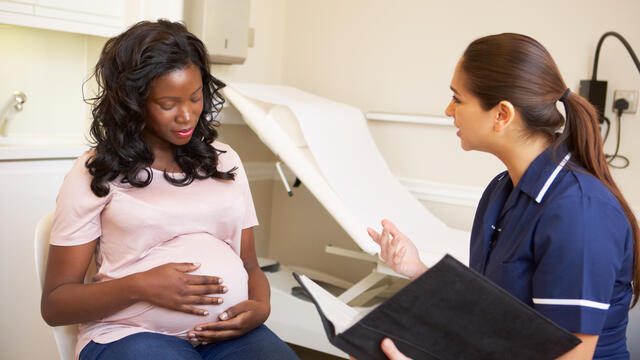Lead-Safe Wisconsin: Stay Safe During Pregnancy and Lactation
Lead is a toxic metal that can harm anyone. It's especially dangerous to pregnant people during pregnancy. Breast milk can contain lead as well. Even low levels of lead can affect both the pregnant person and the developing baby.
To learn more about the impacts of lead exposure, visit: What is Lead Poisoning?
On this page:
Why is lead dangerous during pregnancy?
Lead can build up in your body over time. To your body, lead looks like calcium. Because of this, your body may store lead in your bones the same way it stores calcium. Lead can stay in your bones for decades.
During pregnancy, your body needs extra calcium. Calcium helps your baby grow and develop. If you don't get enough calcium from your diet, your body will pull calcium from your bones. When this happens, any lead stored in your bones can be also be released. This lead can then reenter your bloodstream and get passed on to your baby.
If you were exposed to lead as a child, that lead could still be in your bones. It can affect your baby decades later.
Fetal lead exposure has been linked to:
- Miscarriage.
- Premature birth.
- Low birth weight.
- Developmental delays and learning problems.
- High blood pressure during pregnancy.
To read more about the research on fetal lead exposure, visit: What is Lead Poisoning?
More resources
- Poison control - Lead and Pregnancy
- CDC's (Center for Disease Control and Prevention) Childhood Lead Poisoning Prevention Program (CLPPP) - Risk factors and pregnancy
- American College of Obstetricians and Gynecologists (ACOG) - Lead Screening During Pregnancy and Lactation
Infant feeding and lead
Information about breastfeeding and lactation
The American Academy of Pediatrics (AAP) recommends exclusive breastfeeding for approximately six months after birth, and continued breastfeeding until two years of age or longer while mutually desired by mother and baby.
In nearly all circumstances, breastfeeding is the ideal method for feeding and nurturing infants. In rare occasions, however, breast milk can carry small amounts of lead. If a parent has very high levels of lead in their blood, it may be unsafe to breastfeed.
The CDC recommends blood lead testing if you have any concerns. Talk to your health care provider to make an informed decision about breastfeeding.
Information about formula feeding
No matter how you feed your child, what's important is that they get the nutrition they need to grow up healthy and strong. If you use infant formula to support your child's nutritional needs, please keep these best practices in mind.
Many homes, buildings, and communities in Wisconsin were constructed before lead was banned from plumbing. Because of this, there is a chance that your water may contain lead.
When using water for infant formula:
- Run your water for at least 30 seconds before use. This removes any stagnant water that may have been sitting in leaded pipes or fixtures.
- Use cold water only. Warm water leaches more lead from pipes.
- Consider using a water filter. Any filter with an NSF 53 rating will remove lead from your water. This includes:
- Point-of-use faucet-mounted fixtures.
- Filtered water pitchers.
- Filtered water-bottle fillers.
To learn more, visit: Drinking Water: Lead (DHS)
How you might be exposed to lead
It isn't easy to see the lead around you. Lead can come from:
- Old lead paint and dust in homes and buildings built before 1978.
- Drinking water from lead pipes, fittings, or water fixtures.
- Imported goods, including spices, herbal remedies, cosmetics, and pottery.
- Work or hobbies that involve lead, including construction, painting, auto repair, fishing, hunting, recreational shooting, and stained glass.
- Living with someone who works with lead and may bring dust home on their clothes or shoes.
Even if you don't work with lead directly, you can still be exposed through take-home dust or contaminated products.
To learn more, visit: Sources of Lead.
What you can do
Talk to your doctor or midwife
Ask about the risks of lead exposure, especially if:
- You live in (or regularly visit) a home or building built before 1978.
- You work with materials that may contain lead.
Get a blood lead test
This is the only way to know for sure if you've been exposed to lead. It's especially important to get tested if you're pregnant or planning to become pregnant and are at a higher risk for lead exposure.
Don't forget! Children need blood lead tests, too. Wisconsin recommends testing all children at 12 and 24 months, or any time there's a concern about lead exposure. Babies and toddlers are especially vulnerable to the harmful effects of lead.
Follow best practices to avoid exposure to lead
- Use only cold water from the tap for drinking, cooking and baby formula. You can heat up the water on the stove or microwave afterwards.
- Note: It is not always recommended to microwave baby formula. Always follow instructions before use.
Regularly wipe down high-dust areas with disposable wet wipes. Mop, don't sweep, in areas that could contain lead dust.
- Wash your hands often to reduce exposure to household dust.
Eat a healthy diet rich in calcium, iron, and vitamin C. This can help reduce lead absorption.
The following initiatives support breastfeeding efforts in Wisconsin.
- Women, Infants, and Children (WIC) Breastfeeding and Lactation Support - Receive extra foods to support your nutrition as you feed your baby.
- Find more online recourses here: WIC Breastfeeding Support (USDA)
- Nutrition: Breastfeeding Resources - Find more information on DHS's general resources page for lactating parents.
Keep your home lead-safe
If you live in an older home, look into professional lead-safe renovations or inspections. Never attempt to remove old paint yourself, especially while pregnant.
For renters, reach out to your landlord with any concerns and know your rights.
For more information about lead safety, visit Make Your Home Lead-Safe.


